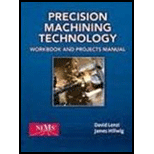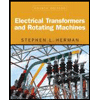
Precision Machining Technology (MindTap Course List)
2nd Edition
ISBN: 9781285444543
Author: Peter J. Hoffman, Eric S. Hopewell, Brian Janes
Publisher: Cengage Learning
expand_more
expand_more
format_list_bulleted
Concept explainers
Textbook Question
Chapter 2.8, Problem 1RQ
Why is a routine maintenance plan important?
Expert Solution & Answer
To determine
The importance of routine maintenance plan.
Explanation of Solution
In case, the owner of a machine never changes its oil, tires, and brakes at a regular interval, the machine will develop complex problems that may cause:
- Increase in the repair expenses.
- Reduction in the efficiency of the machine.
To cope up with such type of complex problems, a routine inspection of the machine parts must be carried out to identify the problems that may affect the working of machine in future. This type of inspection is known as routine maintenance plan.
Routine maintenance plan is important for the following reasons.
- To prevent expensive repairing.
- To increase the life expectancy of the machinery.
- To increase the working efficiency of the machinery.
- To prevent the loss of economy for the company and employee.
- To provide reliable service.
Want to see more full solutions like this?
Subscribe now to access step-by-step solutions to millions of textbook problems written by subject matter experts!
Students have asked these similar questions
For some viscoelastic polymers that are subjected to stress relaxation tests, the stress decays with
time according to
a(t) = a(0) exp(-4)
(15.10)
where σ(t) and o(0) represent the time-dependent and initial (i.e., time = 0) stresses, respectively, and t and T denote
elapsed time and the relaxation time, respectively; T is a time-independent constant characteristic of the material. A
specimen of a viscoelastic polymer whose stress relaxation obeys Equation 15.10 was suddenly pulled in tension to
a measured strain of 0.5; the stress necessary to maintain this constant strain was measured as a function of time.
Determine E (10) for this material if the initial stress level was 3.5 MPa (500 psi), which dropped to 0.5 MPa (70
psi) after 30 s.
For the flows in Examples 11.1 and 11.2, calculate the magnitudes of the Δ V2 / 2 terms omitted in B.E., and compare these with the magnitude of the ℱ terms.
Calculate ℛP.M. in Example 11.2.
Chapter 2 Solutions
Precision Machining Technology (MindTap Course List)
Ch. 2.1 - Briefly describe what you believe are the two most...Ch. 2.1 - Briefly describe what you believe are the two most...Ch. 2.1 - What should be done in the case of a personal...Ch. 2.1 - What does OSHA stand for and what is OSHA's...Ch. 2.1 - List three specific clothing items that should not...Ch. 2.1 - If someone working around machinery has long hair,...Ch. 2.1 - Never operate machinery without proper ______ in...Ch. 2.1 - What is PPE?Ch. 2.1 - What is the most common and important piece of PPE...Ch. 2.1 - What does NFPA stand for?
Ch. 2.1 - What does HMIS stand for?Ch. 2.1 - Prob. 12RQCh. 2.1 - Prob. 13RQCh. 2.1 - Class A fire extinguishers use ______ as a media...Ch. 2.1 - What class of fire extinguisher should be used on...Ch. 2.1 - What class of fire extinguisher should be used on...Ch. 2.1 - What is the purpose of lockout and tagout...Ch. 2.2 - What is the inch equivalent of 1 millimeter?Ch. 2.2 - What is the inch equivalent of 32.5 mm to the...Ch. 2.2 - Use the decimal equivalent chart on page 69 to...Ch. 2.2 - Use the decimal equivalent chart on page 69 to...Ch. 2.2 - Use the decimal equivalent chart on page 69 to...Ch. 2.2 - What does parallel mean?Ch. 2.2 - What does perpendicular mean?Ch. 2.2 - What is the radius of a 3.65-inch-diameter circle?Ch. 2.2 - What is the circumference of the circle in the...Ch. 2.2 - What are the Cartesian coordinates of the four...Ch. 2.2 - Label the hypotenuse, adjacent side, and opposite...Ch. 2.3 - Define semi-precision measurement.Ch. 2.3 - What is comparison measurement?Ch. 2.3 - List three rules to follow when or storing...Ch. 2.3 - List the parts of the combination set.Ch. 2.3 - Describe four uses of the combination set.Ch. 2.3 - What semi-precision tool is used to take angular...Ch. 2.3 - What type of square has a blade that can be tilted...Ch. 2.4 - List three key points in caring for precision...Ch. 2.4 - What type of fixed gage can be used to check hole...Ch. 2.4 - What type of fixed gage can be used to check a...Ch. 2.4 - How is the go member of a go/no-go ring gage set...Ch. 2.4 - What type of fixed gage can be used to check...Ch. 2.4 - A _____________ can provide a reference plane for...Ch. 2.4 - What two other tools could be used with the answer...Ch. 2.4 - ___________ is the process of attaching gage...Ch. 2.4 - What is the smallest graduation on an English...Ch. 2.4 - What is the smallest graduation on a metric...Ch. 2.4 - A micrometer uses an accurate __________ to...Ch. 2.4 - What is the smallest graduation on an inch...Ch. 2.4 - What is the smallest graduation on a metric...Ch. 2.4 - What is calibration and why is it important?Ch. 2.4 - What is a transfer-type measuring tool?Ch. 2.4 - What are the two basic types of indicator...Ch. 2.4 - Briefly describe the main difference between the...Ch. 2.4 - A sine tool uses the trigonometric function of...Ch. 2.4 - List the two most common methods for measuring...Ch. 2.4 - What are one advantage and one disadvantage of...Ch. 2.4 - A(n) ________ displays a magnified image of a part...Ch. 2.4 - What other tool can be useful for measuring very...Ch. 2.4 - What does CMM stand for?Ch. 2.5 - What are the four basic parts of a process plan?Ch. 2.5 - Briefly define quality control and explain its...Ch. 2.5 - Briefly explain the purpose of a sampling plan.Ch. 2.5 - What is the purpose of an inspection plan?Ch. 2.5 - What is the important factor to consider when...Ch. 2.5 - What does SPC stand for?Ch. 2.5 - What does an X-bar chart track?Ch. 2.5 - What does an R-chart track?Ch. 2.5 - If an X-bar chart graph is between LCL and the...Ch. 2.5 - If an X-bar chart graph falls below the LCL or...Ch. 2.6 - What is the difference between ferrous and...Ch. 2.6 - Briefly describe an alloy.Ch. 2.6 - Name three alloying elements added to steel.Ch. 2.6 - What is cast iron?Ch. 2.6 - What element is in stainless steel that makes it...Ch. 2.6 - Small particles of________ alloys are flammable.Ch. 2.6 - What are the two major benefits of titanium?Ch. 2.6 - What does AISI stand for?Ch. 2.6 - What does SAE stand for?Ch. 2.6 - What is (are) the major alloying element(s) in...Ch. 2.6 - What is (are) the major alloying element(s) in...Ch. 2.6 - What does IADS stand for?Ch. 2.6 - What is the overall purity of 1030 aluminum?Ch. 2.6 - What is (are) the major alloying element(s) of...Ch. 2.6 - What does UNS stand for?Ch. 2.7 - Briefly define the term heat treatment.Ch. 2.7 - Direct hardening can be performed on steel...Ch. 2.7 - ________ is the rapid cooling of metal during heat...Ch. 2.7 - What type of hardening operation that leaves the...Ch. 2.7 - In what two ways can the process described in the...Ch. 2.7 - What method is used to harden low-carbon steels?Ch. 2.7 - List two methods of performing the operation...Ch. 2.7 - After hardening, steel is very hard and brittle....Ch. 2.7 - Briefly define annealing.Ch. 2.7 - Prob. 10RQCh. 2.7 - A dual-chamber furnace allows the user...Ch. 2.7 - In addition to standard PPE, what specific PPE and...Ch. 2.7 - What hardness testing scale uses many different...Ch. 2.7 - What is a Brale penetrator and what hardness scale...Ch. 2.8 - Why is a routine maintenance plan important?Ch. 2.8 - What is a lubricant?Ch. 2.8 - List three methods of applying lubricants to...Ch. 2.8 - List two components of machine tools that should...Ch. 2.8 - Briefly describe a gib.Ch. 2.8 - What are the purposes of cutting fluids?Ch. 2.8 - What are the two major types of cutting fluids?Ch. 2.8 - Prob. 8RQCh. 2.8 - What two ingredients are often used as additives...Ch. 2.8 - Oils that can be combined with water are...Ch. 2.8 - What is the major benefit of cutting fluids that...Ch. 2.8 - What is the difference between synthetic and...Ch. 2.8 - A______ can be used to measure cutting fluid...Ch. 2.8 - List three methods of applying cutting fluids.Ch. 2.8 - Always review the________ before using any...Ch. 2.8 - What type of cutting fluids should never be used...
Knowledge Booster
Learn more about
Need a deep-dive on the concept behind this application? Look no further. Learn more about this topic, mechanical-engineering and related others by exploring similar questions and additional content below.Similar questions
- Question 22: The superheated steam powers a steam turbine for the production of electrical power. The steam expands in the turbine and at an intermediate expansion pressure (0.1 MPa) a fraction is extracted for a regeneration process in a surface regenerator. The turbine has an efficiency of 90%. It is requested: Define the Power Plant Schematic Analyze the steam power system considering the steam generator system in the attached figure Determine the electrical power generated and the thermal efficiency of the plant Perform an analysis on the power generated and thermal efficiency considering a variation in the steam fractions removed for regeneration ##Data: The steam generator uses biomass from coconut shells to produce 4.5 tons/h of superheated steam; The feedwater returns to the condenser at a temperature of 45°C (point A); Monitoring of the operating conditions in the steam generator indicates that the products of combustion leave the system (point B) at a temperature of 500°C;…arrow_forwardThis is an old practice exam question.arrow_forwardSteam enters the high-pressure turbine of a steam power plant that operates on the ideal reheat Rankine cycle at 700 psia and 900°F and leaves as saturated vapor. Steam is then reheated to 800°F before it expands to a pressure of 1 psia. Heat is transferred to the steam in the boiler at a rate of 6 × 104 Btu/s. Steam is cooled in the condenser by the cooling water from a nearby river, which enters the condenser at 45°F. Use steam tables. NOTE: This is a multi-part question. Once an answer is submitted, you will be unable to return to this part. Determine the pressure at which reheating takes place. Use steam tables. Find: The reheat pressure is psia. (P4)Find thermal efficiencyFind m dotarrow_forward
- Air at T1 = 24°C, p1 = 1 bar, 50% relative humidity enters an insulated chamber operating at steady state with a mass flow rate of 3 kg/min and mixes with a saturated moist air stream entering at T2 = 7°C, p2 = 1 bar. A single mixed stream exits at T3 = 17°C, p3 = 1 bar. Neglect kinetic and potential energy effects Determine mass flow rate of the moist air entering at state 2, in kg/min Determine the relative humidity of the exiting stream. Determine the rate of entropy production, in kJ/min.Karrow_forwardAir at T1 = 24°C, p1 = 1 bar, 50% relative humidity enters an insulated chamber operating at steady state with a mass flow rate of 3 kg/min and mixes with a saturated moist air stream entering at T2 = 7°C, p2 = 1 bar. A single mixed stream exits at T3 = 17°C, p3 = 1 bar. Neglect kinetic and potential energy effects Determine mass flow rate of the moist air entering at state 2, in kg/min Determine the relative humidity of the exiting stream. Determine the rate of entropy production, in kJ/min.Karrow_forwardAir at T1 = 24°C, p1 = 1 bar, 50% relative humidity enters an insulated chamber operating at steady state with a mass flow rate of 3 kg/min and mixes with a saturated moist air stream entering at T2 = 7°C, p2 = 1 bar. A single mixed stream exits at T3 = 17°C, p3 = 1 bar. Neglect kinetic and potential energy effects (a) Determine mass flow rate of the moist air entering at state 2, in kg/min (b) Determine the relative humidity of the exiting stream. (c) Determine the rate of entropy production, in kJ/min.Karrow_forward
- A simple ideal Brayton cycle operates with air with minimum and maximum temperatures of 27°C and 727°C. It is designed so that the maximum cycle pressure is 2000 kPa and the minimum cycle pressure is 100 kPa. The isentropic efficiencies of the turbine and compressor are 91% and 80%, respectively, and there is a 50 kPa pressure drop across the combustion chamber. Determine the net work produced per unit mass of air each time this cycle is executed and the cycle’s thermal efficiency. Use constant specific heats at room temperature. The properties of air at room temperature are cp = 1.005 kJ/kg·K and k = 1.4. The fluid flow through the cycle is in a clockwise direction from point 1 to 4. Heat Q sub in is given to a component between points 2 and 3 of the cycle. Heat Q sub out is given out by a component between points 1 and 4. An arrow from the turbine labeled as W sub net points to the right. The net work produced per unit mass of air is kJ/kg. The thermal efficiency is %.arrow_forwardSteam enters the high-pressure turbine of a steam power plant that operates on the ideal reheat Rankine cycle at 700 psia and 900°F and leaves as saturated vapor. Steam is then reheated to 800°F before it expands to a pressure of 1 psia. Heat is transferred to the steam in the boiler at a rate of 6 × 104 Btu/s. Steam is cooled in the condenser by the cooling water from a nearby river, which enters the condenser at 45°F. Use steam tables. NOTE: This is a multi-part question. Once an answer is submitted, you will be unable to return to this part. Determine the pressure at which reheating takes place. Use steam tables. The reheat pressure is psia.Find thermal efficieny Find m dotarrow_forwardThis is an old exam practice question.arrow_forward
- As shown in the figure below, moist air at T₁ = 36°C, 1 bar, and 35% relative humidity enters a heat exchanger operating at steady state with a volumetric flow rate of 10 m³/min and is cooled at constant pressure to 22°C. Ignoring kinetic and potential energy effects, determine: (a) the dew point temperature at the inlet, in °C. (b) the mass flow rate of moist air at the exit, in kg/min. (c) the relative humidity at the exit. (d) the rate of heat transfer from the moist air stream, in kW. (AV)1, T1 P₁ = 1 bar 11 = 35% 120 T₂=22°C P2 = 1 bararrow_forwardAir at T₁-24°C, p₁-1 bar, 50% relative humidity enters an insulated chamber operating at steady state with a mass flow rate of 3 kg/min and mixes with a saturated moist air stream entering at T₂-7°C, p2-1 bar. A single mixed stream exits at T3-17°C, p3-1 bar. Neglect kinetic and potential energy effects Step 1 Your answer is correct. Determine mass flow rate of the moist air entering at state 2, in kg/min. m2 = 2.1 Hint kg/min Using multiple attempts will impact your score. 5% score reduction after attempt 2 Step 2 Determine the relative humidity of the exiting stream. Փ3 = i % Attempts: 1 of 3 usedarrow_forwardA reservoir at 300 ft elevation has a 6-in.-diameter discharge pipe located 50 ft below the surface. The pipe is 600 ft long and drops in elevation to 150 ft where the flow discharges to the atmosphere. The pipe is made of riveted steel with a roughness height of 0.005 ft. Determine the flow rate without a head loss Determine the flow rate with the pipe friction head loss. (hints: Since the velocity is not known for part b and the Reynolds number and friction factor depend on velocity, you will need to iterate to find the solution. A good first guess is the velocity from part (a))arrow_forward
arrow_back_ios
SEE MORE QUESTIONS
arrow_forward_ios
Recommended textbooks for you
 Precision Machining Technology (MindTap Course Li...Mechanical EngineeringISBN:9781285444543Author:Peter J. Hoffman, Eric S. Hopewell, Brian JanesPublisher:Cengage Learning
Precision Machining Technology (MindTap Course Li...Mechanical EngineeringISBN:9781285444543Author:Peter J. Hoffman, Eric S. Hopewell, Brian JanesPublisher:Cengage Learning Welding: Principles and Applications (MindTap Cou...Mechanical EngineeringISBN:9781305494695Author:Larry JeffusPublisher:Cengage Learning
Welding: Principles and Applications (MindTap Cou...Mechanical EngineeringISBN:9781305494695Author:Larry JeffusPublisher:Cengage Learning Automotive TechnologyMechanical EngineeringISBN:9781337794213Author:ERJAVEC, Jack.Publisher:Cengage,
Automotive TechnologyMechanical EngineeringISBN:9781337794213Author:ERJAVEC, Jack.Publisher:Cengage, Electrical Transformers and Rotating MachinesMechanical EngineeringISBN:9781305494817Author:Stephen L. HermanPublisher:Cengage Learning
Electrical Transformers and Rotating MachinesMechanical EngineeringISBN:9781305494817Author:Stephen L. HermanPublisher:Cengage Learning

Precision Machining Technology (MindTap Course Li...
Mechanical Engineering
ISBN:9781285444543
Author:Peter J. Hoffman, Eric S. Hopewell, Brian Janes
Publisher:Cengage Learning

Welding: Principles and Applications (MindTap Cou...
Mechanical Engineering
ISBN:9781305494695
Author:Larry Jeffus
Publisher:Cengage Learning

Automotive Technology
Mechanical Engineering
ISBN:9781337794213
Author:ERJAVEC, Jack.
Publisher:Cengage,

Electrical Transformers and Rotating Machines
Mechanical Engineering
ISBN:9781305494817
Author:Stephen L. Herman
Publisher:Cengage Learning
General Industrial Safety; Author: Jim Pytel;https://www.youtube.com/watch?v=RXtF_vQRebM;License: Standard youtube license